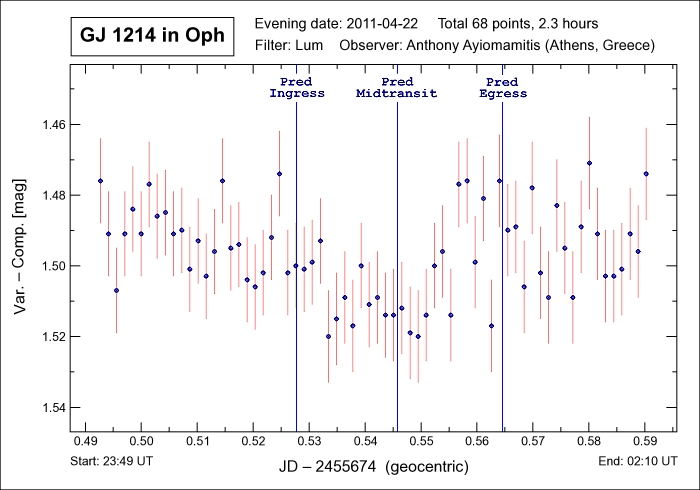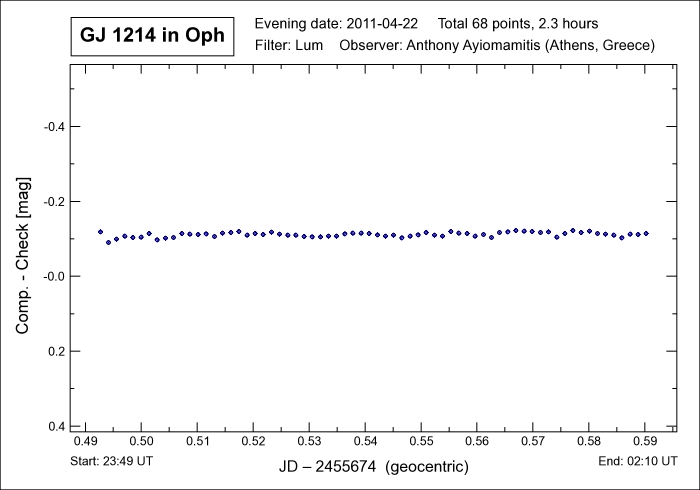
A variable star, as its name suggests, is a star whose magnitude varies intrinsically, in contrast to eclipsing
binaries whose magnitude varies as a result of one star in the binary system eclipsing the other. True variables are
one of five types, namely Mira stars, semiregular stars, cepheids, eruptive variables and, finally, cataclysmic
variables. Minimum to maximum magnitude can range from days to many months with some variables displaying irregular
periods.
A popular method for the study of variable stars, particularly short-term variables, is by the use of the technique
known as "differential photometry". Rather than measure the (variable) magnitude of a variable star on an absolute
scale, measurements are made over time relative to one or more non-variable star(s) and these differences are then
plotted so as to study and illustrate the relative or differential change in magnitude. Due to the very large number
of variables stars, the field of differential photometry represents one of the key fields in astronomy whereby the
amateur astronomer can make a meaningful and long-lasting contribution to both science and astronomy.
More recently, the search for extrasolar planets (453 discovered so far) has identified yet another interesting
application for the practice of differential photometry whereby the minute drops in magnitude of a star hosting an
exoplanet are studied. Further details for the interested party are available
here.
Note: The light curve for exoplanet GJ 1214b in Ophiuchus depicted below is one of the
latest transiting exoplanets, having being announced in Dec/2009, and represents a discovery of the MEarth Project
which monitors 2,000 nearby dwarf stars with a mass between 0.10 and 0.35 solar masses for habitable earth-type
exoplanets.
GJ 1214b is characterized as a super-earth exoplanet with a whopping mass 6.55 times that of Earth while its radius
is equivalent to 2.68 earth radii, thus making this exoplanet a dense super-earth discovery. GJ 1214b requires 52
minutes to transit its parent star at a depth of 17.0 mmag or 1.70% during a 38-hr orbit about its host star.
The parent star, USNO-B1 0949-00280047, is a high-proper motion M4.5 dwarf estimated to have a mass of 0.157 solar
masses, a radius equivalent to 0.211 solar radii, a temperature of 3,026° K and to lie at a distance of 42.4
light-years away with a visual magnitude of 14.67. Further details regarding GJ 1214 and GJ 1214b are available in
the paper published by the discovery team led by David Charbonneau et al
here.
Note: The C- and K-stars used for the purposes of the differential photometry measurements
depicted below were GSC 408:212 (mag 11.70) and GSC 408:269 (mag 11.70) respectively.
Note: With a (very) dim magnitude of 14.67 for the host star, the transit for exoplanet
GJ 1214b is a most-formidable task. A repeat visit is planned with a large-aperture astrograph (AP 305/f3.8
Riccardi-Honders AG).
|
Parent Star: USNO-B1 0949-00280047 GSC/SAO Catalog: N/A Constellation: Ophiuchus RA / Dec: 17h 15m 18.94s / +04° 57' 49.7" Magnitude: 14.67 Distance: 42.4 light-years Exoplanet: GJ 1214b Period: 1.5803925 + 0.0000117 d Transit Duration: 52 mins Transit Depth: 17.0 mmag Minimum Mass: 0.0179 MJup Radius: 0.2415 RJup Pred Transit Details:
Moon Phase: 70.8% |
 
|
Date: April 23, 2011 02:48:30 - 05:11:02 UT+3 Location: Athens, Greece Equipment: AP 160 f/7.5 Starfire EDF AP 1200GTO GEM SBIG ST-10XME SBIG CFW-10 SBIG LRGB filters Integrations:
Temperatures:
Software: CCDSoft V5.00.201 AIP4Win V2.4.0 Processing: Reduction Differential Photometry |